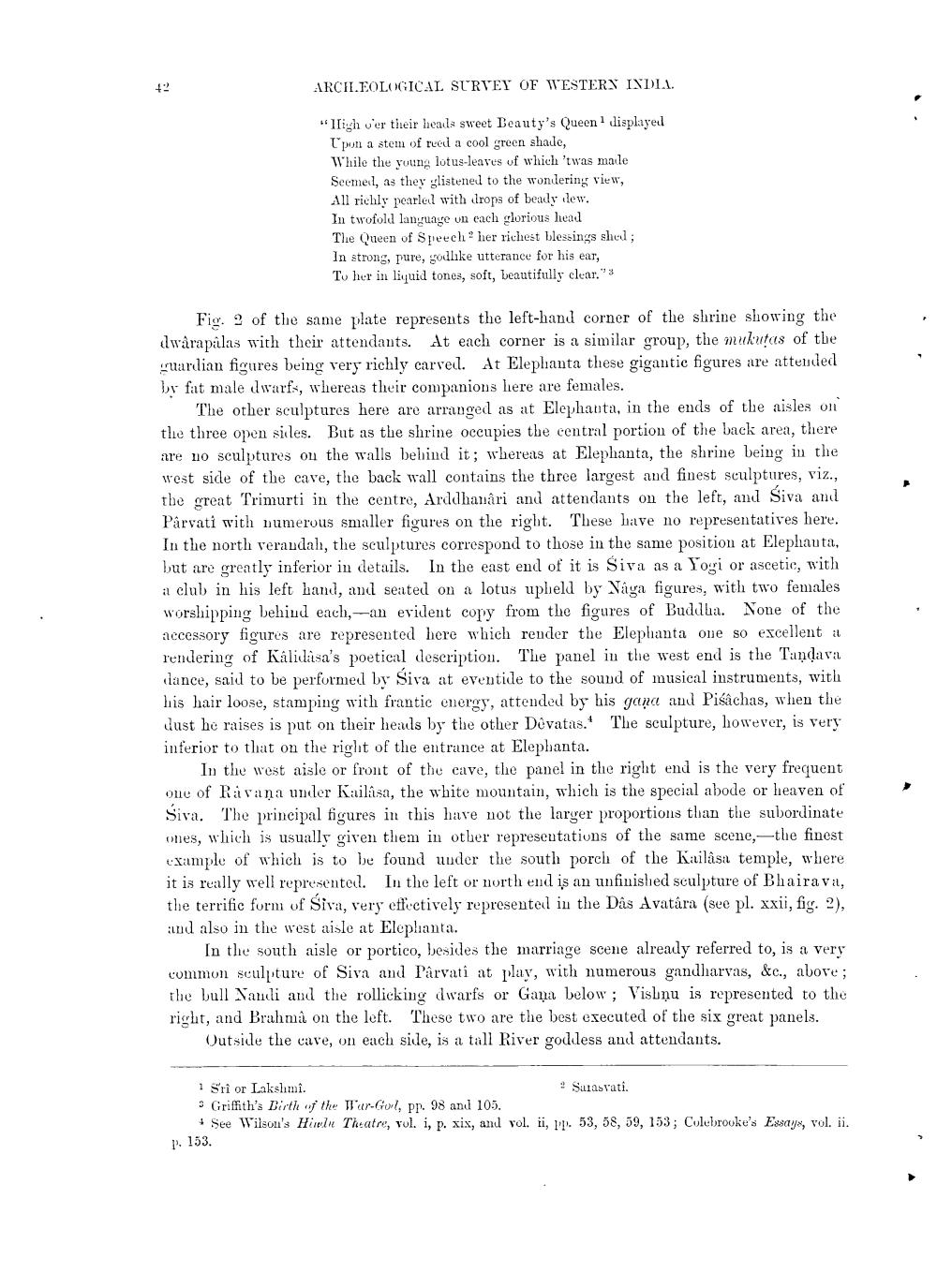________________
42
ARCHEOLOGICAL SURVEY OF WESTERN INDIA.
"High o'er their heads sweet Beauty's Queen displayed Upon a stem of reed a cool green shade,
While the young lotus-leaves of which 'twas made Seemed, as they glistened to the wondering view, All richly pearled with drops of beady dew.
In twofold language on each glorious head The Queen of Speech her richest blessings shed; In strong, pure, godlike utterance for his ear, To her in liquid tones, soft, beautifully clear."3
Fig. 2 of the same plate represents the left-hand corner of the shrine showing the dwarapalas with their attendants. At each corner is a similar group, the mukutas of the guardian figures being very richly carved. At Elephanta these gigantie figures are attended by fat male dwarfs, whereas their companions here are females.
The other sculptures here are arranged as at Elephanta, in the ends of the aisles on the three open sides. But as the shrine occupies the central portion of the back area, there are no sculptures on the walls behind it; whereas at Elephanta, the shrine being in the west side of the cave, the back wall contains the three largest and finest sculptures, viz., the great Trimurti in the centre, Arddhanâri and attendants on the left, and Śiva and Pârvati with numerous smaller figures on the right. These have no representatives here. In the north verandah, the sculptures correspond to those in the same position at Elephauta, but are greatly inferior in details. In the east end of it is Siva as a Yogi or ascetic, with a club in his left hand, and seated on a lotus upheld by Naga figures, with two females worshipping behind each, an evident copy from the figures of Buddha. None of the accessory figures are represented here which render the Elephants one so excellent a rendering of Kálisisa's poetical description. The panel in the west end is the Tandava. dance, said to be performed by Siva at eventide to the sound of musical instruments, with his hair loose, stamping with frantic energy, attended by his gana and Pisâchas, when the dust he raises is put on their heads by the other Devatas. The sculpture, however, is very inferior to that on the right of the entrance at Elephanta.
In the west aisle or front of the cave, the panel in the right end is the very frequent one of Ravana under Kailasa, the white mountain, which is the special abode or heaven of Siva. The principal figures in this have not the larger proportions than the subordinate ones, which is usually given them in other representations of the same scene, the finest example of which is to be found under the south porch of the Kailasa temple, where it is really well represented. In the left or north end is an unfinished sculpture of Bhairava, the terrific form of Siva, very effectively represented in the Dis Avatara (see pl. xxii, fig. 2). and also in the west aisle at Elephanta.
In the south aisle or portico, besides the marriage scene already referred to, is a very common sculpture of Siva and Pârvati at play, with numerous gandharvas, &c., above; the bull Nandi and the rollicking dwarfs or Gapa below; Vishnu is represented to the right, and Brahmâ on the left. These two are the best executed of the six great panels. Outside the cave, on each side, is a tall River goddess and attendants.
2 Sarasvati.
1 Sri or Lakshmi.
3 Griffith's Birth of the War-God, pp. 98 and 105.
See Wilson's Hilu Theatre, vol. i, p. xix, and vol. ii, pp. 53, 58, 59, 153; Colebrooke's Essays, vol. ii.
P. 153.




